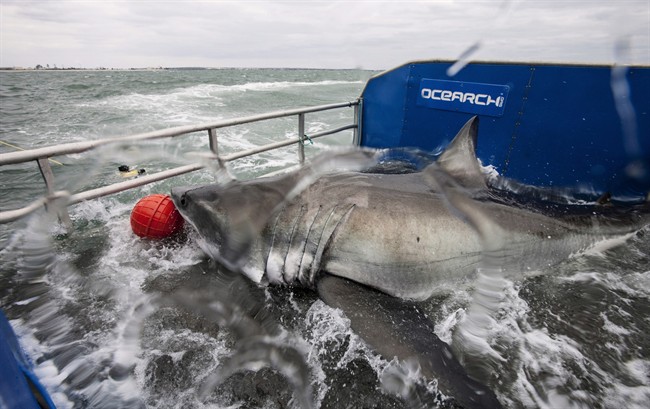ST. JOHN’S, N.L. – Lydia has her own Twitter account and a dorsal fin tracker that over the last two years has given scientists and the public first ever details about great white sharks.

Since she was tagged with a locator device off Jacksonville, Fla., on March 3, 2013, Lydia has travelled more than 56,000 kilometres over the mid-Atlantic ridge toward Europe and western Africa then back again.
READ MORE: Lydia the great white shark once again nearing Canada
She appears to be navigating an uncannily accurate pattern that had her making a beeline for the Florida coast almost exactly two years to the day she was tagged. In both years she swam from the southeastern United States up to the waters off Newfoundland before heading out into the open North Atlantic.
Almost 3,000 Twitter fans are following the five-metre, 1,400-kilogram shark believed to be in her late 20s or early 30s. They can trace Lydia’s exploits each time her fin breaks water, pinging new data by satellite to computer trackers.
Emerging is a long term view of one of the ocean’s top predators that is revamping what researchers thought they knew.

“What we previously considered to be a much smaller habitat scope, thanks to Lydia, is much larger,” Gregory Skomal, a senior scientist at the Massachusetts division of Marine Fisheries, said from Bedford, Mass.
“We’re talking about habitat that spans the entire North Atlantic ocean. That’s amazing, and we’re getting that from Lydia.”
It’s hoped that the battery on her fin device will hold out for another three years, allowing researchers to fill in gaps, such as where she might give birth.
Understanding Lydia’s habitat will help craft conservation plans to protect great whites as a vital part of ocean ecosystems, Skomal said.
READ MORE: 5 shark myths, debunked
“Is she going to reveal for us nursery areas for white sharks?” he wonders. “We’re hoping that as the patterns emerge from sharks like Lydia, we’re able to tease out some of these aspects of the natural history of the animal that we just don’t know.”
It’s a marvel of technological progress in the last decade that such a far roaming creature can be traced so closely for so long, he said.
Chris Fischer, chairman and expedition leader for the non-profit group Ocearch, said Lydia was tagged thanks to a specialized lift that raised her from the water and on to a vessel deck after she was hooked using bait.
Hoses were put in her mouth to allow her to breathe as a team of scientists conducted about 12 research projects in 15 minutes including blood samples, he said in an interview.
“It has just exploded the science forward on these apex predators … which are essential to make sure we have a future ocean full of fish.”
READ MORE: Why these shark researchers are mourning just days after celebrating
Robert Hueter, director of the Center for Shark Research at the Mote Marine Laboratory in Sarasota, Fla., said Lydia’s vast range is instructive.
“If we want to understand these animals and even more importantly, protect them from extinction, then we’ve got to work with other countries.”
Lydia has travelled north when scientists would have expected her to be south. Another tracking tag indicated she dives more than 1,000 metres deep, Hueter said.
Anyone can follow Lydia online to see the latest data as researchers are getting it, he added.
“This is a very inclusive process of engaging not just fellow scientists but the public as we watch Lydia do her thing.”

Comments